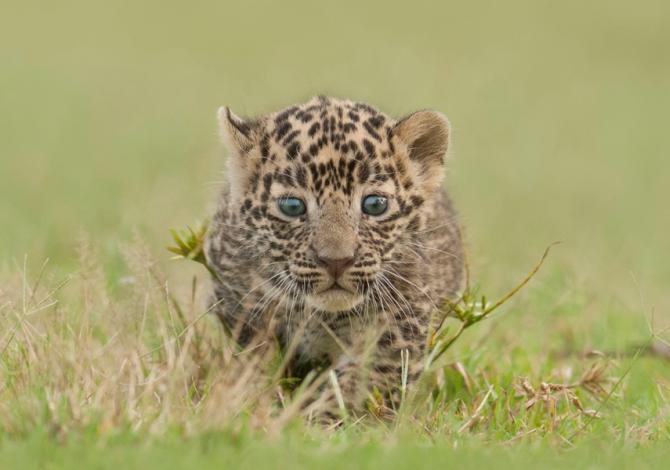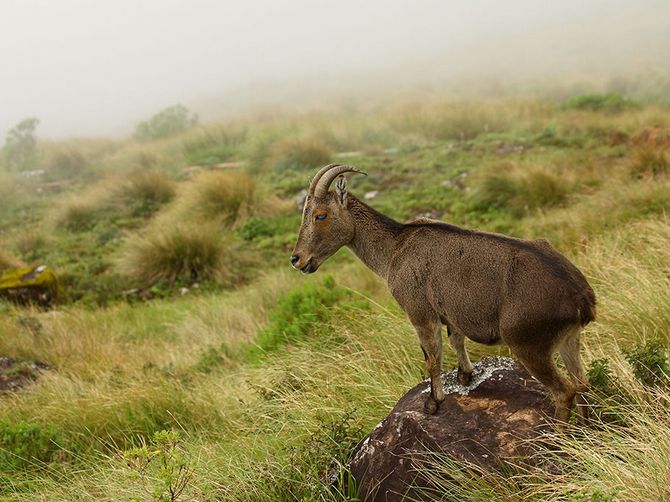 | « Back to article | Print this article |
Condé Nast Traveller sorted through the wish lists of wildlife enthusiasts from around the world to collate this definitive guide. How many will you cross off?
~ Bittu Sahgal: Editor, Sanctuary Asia
In 1981, Bittu Sahgal started Sanctuary, India's first wildlife and environment conservation magazine. He has been associated with Project Tiger from its inception, and one of the missions he began, Kids for Tigers, reaches out to 650 schools across 15 Indian cities, covering over a million children.
He recommends:
1. Hike in Clouded Leopard Country, West Bengal

Photograph: Shaaz Jung
Why: In the thick forests bordering Bhutan lives one of the most secretive wild cats in the world. As comfortable up in trees as it is on the ground, the clouded leopard has been hunted for centuries for its exquisitely patterned fur. This is neither a small cat, nor a great cat, though scientists club it with lions, tigers, jaguars and common leopards.
There are few evergreen, orchid- and liana-studded wonderlands that can hold a candle to the rich and diverse Buxa Tiger Reserve, home to this shadowy cat. Two swift rivers, the Raidak and Jayanti, water this jungle, which also supports elephants, tigers, leopards, hispid hares, pangolins and about 300 bird species, including the endangered Bengal florican.
Buxa is a trekker's paradise boasting ancient forts, caves and jungle trails, which you can enjoy in the company of expert naturalists and local guides.
When: Avoid the monsoon (mid-June-mid-September). And be warned, October-January (holiday season) is relatively crowded.
CNT Tip: Land at Bagdogra Airport and make your way to Alipurduar, 150km away, from where you could be in clouded leopard country within the hour. A four-day trip is ideal.
2. Spy the Nilgiri Tahr, Eravikulam, Kerala

Photograph: Navaneeth Kishor/Wikimedia Creative Commons
Why: The picturesque high ranges of the Western Ghats, older than the Himalayas, offer refuge to the endangered goat-antelope, the Nilgiri tahr. The best place to sight it is the contiguous forested belt comprising the Anaimalai-Parambikulam and Eravikulam areas.
If you like walking, you'll enjoy little discovered trekking and birding destinations, all within a landscape that is acknowledged by experts to be one of the top 10 global biodiversity hotspots. These hills and the tahr have been protected for more than a century by the Nilgiri Wildlife ... Environment Association (NWEA), based in Ooty.
When: Since much of the terrain is at an elevation of around 2,000 metres, the weather encourages walking through the year. Avoid the monsoon; it comes with leeches.
CNT Tip: Base yourself in Munnar. Choose the drive-walk option and connect with a good, knowledgeable naturalist-guide for a complete experience. Wear anti-leech socks after the monsoon and stock up on herbal insect repellents.
3. Spot a Snow Leopard, Ladakh

Photograph: William Warby/Wikimedia Creative Commons
Why: The snow leopard is the spirit of the central and southern Asian Himalayas. Sighting one, even just a pugmark, scat or kill, reassures you that the highest mountain chain in the world is in fine fettle because clearly, the snow leopard's prey (wild goats, marmots, voles) is thriving. Avoid baited peep shows; they adversely affect the behaviour of this wild cat.
You'll be surprised how body and soul can be cleansed by walking, stopping to catch a breath, scanning slopes for the cat, then repeating the process in the company of life-loving locals. You will encounter scores of other Himalayan life forms, including eagles, wolves, foxes and weasels. An actual snow leopard sighting, of course, would be a blessed experience. But what you will remember is the journey, not the goal.
When: November-February, when leopards can be seen at lower altitudes.
CNT Tip: Give yourself time to get acclimatised. Go to Rumbak Valley in the Hemis High Altitude National Park, Ladakh.
~ Abhinav Dhar: Founding partner, Dhar ... Hoon Communication
Number of Safaris: 50+
Ad veteran Abhinav's childhood love of art has evolved into a passion for capturing the wild through his camera lens.
He recommends:

Photograph: Koshy Koshy/Wikimedia Creative Commons
Track Tigers at Bandhavgarh, Madhya Pradesh
Why: Bandhavgarh in three words? 'Tigers, tigers, tigers'.
If one is looking to find this elusive big cat in a quintessentially Indian, Jungle Book-like setting, Bandhavgarh Tiger Reserve is the place. It used to be the exclusive hunting preserve of the maharajas of the ancient kingdom of Rewa in central India, but now it's one of the definitive tiger-sighting hotspots in the world. Whether on a jeep safari or on elephant-back, the odds of seeing a tiger here are heavily in your favour, because Bandhavgarh has among the highest densities of tigers of any game park in India.
Home to a 2,000-year-old fort, and surrounded by cliffs, the jungle is dotted with ancient temples and idols. The cats mingling freely in this beautiful setting makes it a delightfully surreal wildlife experience.
When: February-April, when it's cool and the skies are clear. May- June are good for hardcore wildlife fans, because the heat forces the animals to come to the water.
CNT Tip: Three or four nights at Bandhavgarh are ideal. Stay at Tree House Hideaway or Samode Safari Lodge.
~ Bahar Dutt: Environment Editor, CNN-IBN
Her work resulted in the channel winning the Sanctuary-RBS Wind under the Wings Award 2008.
She recommends:
See Nesting Sea Turtles, Odisha

Photograph: Reuters
Why: The mass nesting of sea turtles (or arribada, meaning 'arrival by sea' in Spanish) is one of those natural wonders that compares with events such as the Northern Lights or the Great Migration. Thousands of turtles land on Odisha's coast, year after year, as they have done for centuries, to breed in the shallow waters off the coast and then lay their eggs on its sandy beaches.
Hatching takes place at three distinct locations: the beach in Gahirmatha Marine Sanctuary, the Devi River mouth and on the banks of the Rushikulya River.
Gahirmatha, near the Bhitarkanika National Park, gets the highest number of turtles (around four lakh in 2013, though numbers have been declining). If you want to beat the crowds, Rushikulya beach has seen an increase in hatching, thanks to fishermen who operate in a community-protected area.
When: Mid-February to mid-March is when turtles arrive to nest; thousands of hatchlings make their way to the sea mid- March-May.
CNT Tip: To visit Gahirmatha beach, in the marine sanctuary, you have to enter from Bhitarkanika National Park, 140km from Cuttack by road. The Forest Department provides boats to reach the nesting sites. The Rushikulya Sea Turtle Protection Committee regulates tourist traffic in Rushikulya.
~ Geetika Jain: Travel Writer, Hindustan Times, Business Standard, The Sunday Times Travel Magazine, UK and Conde Nast Traveller, USA.
Number of Safaris: 35+
Geetika Jain based in New York and London. She enjoys a special interest in wildlife and would like to see India's magnificent wilderness preserved for future generations.
She recommends:
Lock Eyes with Rhinos, Assam

Photograph: Michel Figuet
Why: The Indian one-horned rhinoceros is a rare, Jurassic-era curiosity that narrowly escaped extinction a century ago. Today, in Assam's Kaziranga National Park, there are more than 2,200 of them. Observe their armoured flanks and coveted horns up close on elephant-back and observe your Gypsy driver plan his escape route in case of a (not uncommon) rhino charge.
The park's elephant-grass meadows, swampy lagoons and dense forests meld to create an excruciatingly beautiful setting. Standing at the machan at Dunga Beel, you'll see herds of wild buffalo, barasingha, hog deer and wild boar, as bar-headed geese flock to the lake and giant hornbills nest in the treetops above you.
When: The park is open from mid-October to mid-April. Weekdays are less crowded.
CNT Tip: Stay at Wild Grass Lodge, fairly close to the park. Tarun Gogoi is one of their best guides, and he is particularly knowledgeable about birds. Visit nearby Panbari, a small patch of forest, to watch hoolock gibbons.
~ Swati Thiyagarajan: International award winning conservation journalist
She began her television career with NDTV in 1997. She has travelled and reported live news from around the world and anchored news and feature shows. She has twice won India's equivalent to the Pulitzer Prize, the Ramnath Goenka Award and was awarded the Earth hero award for her work in conservation, and the Carl Ziess Award for her reports on tiger conservation.
She recommends:
Catch Sight of a Tiger, Tadoba

Photograph: Shaaz Jung
Why: One can never guarantee a tiger sighting, but at Tadoba-Andhari Tiger Reserve, the chances are unusually high. Consisting of lush teak and bamboo forests dotted with marshes, grasslands and lakes, Tadoba also has leopards, gaurs, sloth bears and crocodiles on offer.
With the last census, in 2010, putting tiger numbers at 67 in this reserve, spotting them at waterholes or relaxing in a bamboo thicket, or even killing a gaur, as two of them recently did in front of tourists in the buffer zone, is not uncommon.
There are also kingfishers, painted sand grouses, lapwings, owls, paradise flycatchers, eagles, vultures and many other birds. A lazy rock python and a few monitor lizards might make an appearance, too.
When: March-May is the best time to see tigers. December-March is pleasant, but the post-monsoon foliage makes spotting tricky.
CNT Tip: Stay at the Tiger Trails Jungle Lodge, which is very close to the park and where every room has fantastic views. There is also a great new tented camp called Irai Safari Retreat.
To read more about Wildlife Safaris, grab a copy of Wildlife ... Safari Special supplement, free with Condé Nast Traveller August ... September 2014 issue, out on stands